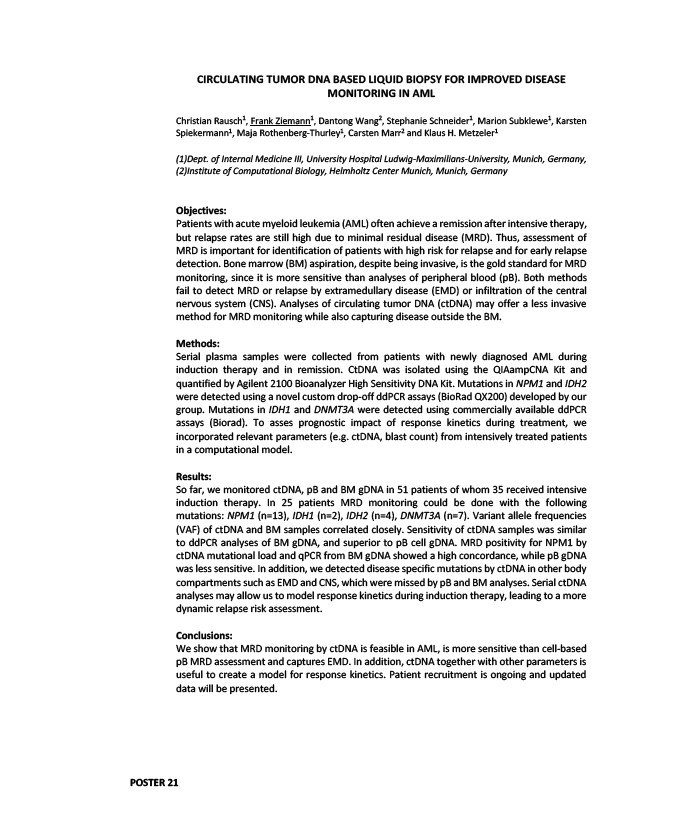
CIRCULATING TUMOR DNA BASED LIQUID BIOPSY FOR IMPROVED DISEASE
MONITORING IN AML
Christian Rausch1, Frank Ziemann1, Dantong Wang2, Stephanie Schneider1, Marion Subklewe1, Karsten
Spiekermann1, Maja Rothenberg-Thurley1, Carsten Marr2 and Klaus H. Metzeler1
(1)Dept. of Internal Medicine III, University Hospital Ludwig-Maximilians-University, Munich, Germany,
(2)Institute of Computational Biology, Helmholtz Center Munich, Munich, Germany
Objectives:
Patients with acute myeloid leukemia (AML) often achieve a remission after intensive therapy,
but relapse rates are still high due to minimal residual disease (MRD). Thus, assessment of
MRD is important for identification of patients with high risk for relapse and for early relapse
detection. Bone marrow (BM) aspiration, despite being invasive, is the gold standard for MRD
monitoring, since it is more sensitive than analyses of peripheral blood (pB). Both methods
fail to detect MRD or relapse by extramedullary disease (EMD) or infiltration of the central
nervous system (CNS). Analyses of circulating tumor DNA (ctDNA) may offer a less invasive
method for MRD monitoring while also capturing disease outside the BM.
Methods:
Serial plasma samples were collected from patients with newly diagnosed AML during
induction therapy and in remission. CtDNA was isolated using the QIAampCNA Kit and
quantified by Agilent 2100 Bioanalyzer High Sensitivity DNA Kit. Mutations in NPM1 and IDH2
were detected using a novel custom drop-off ddPCR assays (BioRad QX200) developed by our
group. Mutations in IDH1 and DNMT3A were detected using commercially available ddPCR
assays (Biorad). To asses prognostic impact of response kinetics during treatment, we
incorporated relevant parameters (e.g. ctDNA, blast count) from intensively treated patients
in a computational model.
Results:
So far, we monitored ctDNA, pB and BM gDNA in 51 patients of whom 35 received intensive
induction therapy. In 25 patients MRD monitoring could be done with the following
mutations: NPM1 (n=13), IDH1 (n=2), IDH2 (n=4), DNMT3A (n=7). Variant allele frequencies
(VAF) of ctDNA and BM samples correlated closely. Sensitivity of ctDNA samples was similar
to ddPCR analyses of BM gDNA, and superior to pB cell gDNA. MRD positivity for NPM1 by
ctDNA mutational load and qPCR from BM gDNA showed a high concordance, while pB gDNA
was less sensitive. In addition, we detected disease specific mutations by ctDNA in other body
compartments such as EMD and CNS, which were missed by pB and BM analyses. Serial ctDNA
analyses may allow us to model response kinetics during induction therapy, leading to a more
dynamic relapse risk assessment.
Conclusions:
We show that MRD monitoring by ctDNA is feasible in AML, is more sensitive than cell-based
pB MRD assessment and captures EMD. In addition, ctDNA together with other parameters is
useful to create a model for response kinetics. Patient recruitment is ongoing and updated
data will be presented.
POSTER 21